21 Top Digital Marketing Tools to Boost Business Growth in 2023
Is it possible to run a digital marketing strategy manually?
Well, it is, but with so many marketing automation tools available online, why would you put yourself through something like this?
A whole other story is what solution to choose since there are quite a few, and such an abundance can sometimes be overwhelming.
To save you time, we’ve compiled a list of these solutions and broken them down into categories. Some of the best digital marketing tools for taking your marketing approach to the next level are Ahrefs, Semrush, Buffer, Mailchimp, Hootsuite, Kissmetrics, Plerdy, Canva, and many others.
In this guide, you will find a full comparison between these platforms and learn about use cases, features, and pricing.
Disclaimer: The information below is accurate as of September 7, 2022.
Comparison Table of Best Digital Marketing Tools (Use Cases, Features & Pricing)
Our list is quite extensive, so if you don’t have the time to go through each tool individually, we’ve prepared a comprehensive graph featuring the use case, features, and pricing of each digital marketing solution; take a look:

Now, let us break down these platforms into categories, so you can easily navigate them based on your current digital marketing needs.
Search Engine Optimization (SEO) Tools
We are going to start with search engine optimization – one of the most important but very time-consuming strategies in online marketing.
This category will feature some of the best players in this field – Ahrefs, Semrush, and Clearscope.
SEO Tool #1: Ahrefs
Ahrefs is an all-in-one SEO tool with solutions for keyword research and optimization, link building, site audit, tracking mentions, and more.

The platform boasts an impressive keyword database containing 17.3 billion queries, according to Ahrefs’ February report.
Now, let’s review its use case and features in more detail.
Who is it for?
Ahrefs is a great tool for digital marketing teams who want to scale their SEO strategy, especially in terms of link building – this platform has many helpful and detailed reports on the growth of the backlink profile, referring domains, etc.
Ahrefs features
This search engine optimization tool offers the following solutions:
- Site Explorer
- Keywords Explorer (includes keyword variations, search volume, keyword difficulty, etc.)
- Site Audit
- Rank Tracker
- Content Explorer
You can also take advantage of the Batch Analysis tool, Domain Comparison, and install Ahrefs as a WordPress plugin and a Chrome extension toolbar.
Ahrefs pricing
There is a free version of Ahrefs for everyone interested in trying it, but the features will be limited only to your website and available only after you verify website ownership. If you want extended functionality, consider the cheapest Lite plan, which costs $99 a month.
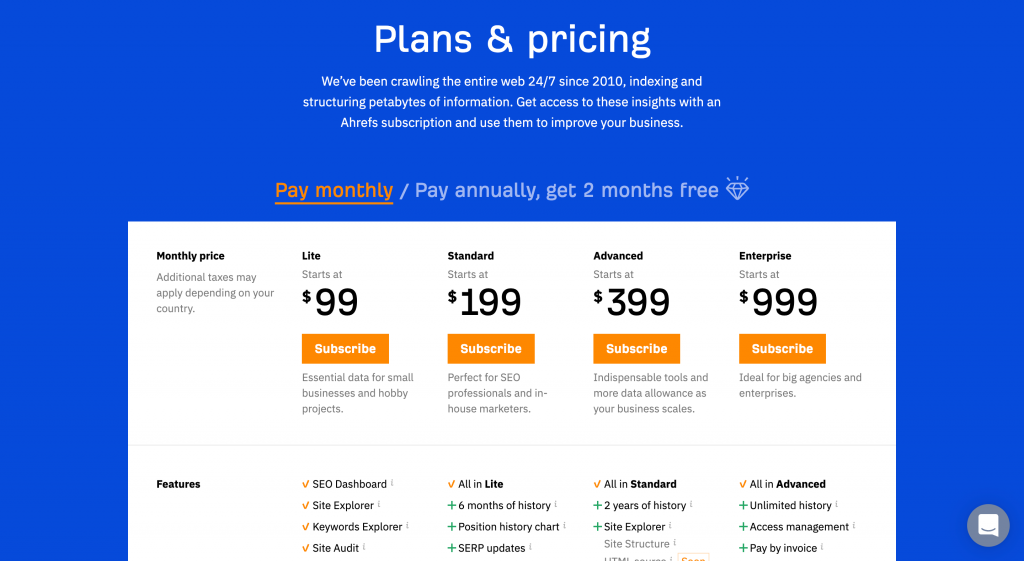
The Lite subscription is perfect for small businesses and projects. However, if you’re an SEO professional or an in-house marketer, it’s better to go for the Standard subscription or an Advanced plan, which is necessary if your business grows fast. The Enterprise option is mainly for agencies and large companies.
Off to the next SEO solution.
SEO Tool #2: Semrush
Semrush is a search engine optimization platform with tools for keyword research, competitor analysis, link building, on-page SEO, local SEO, online advertising, social media management, content marketing, etc.

As you can see, it’s pretty similar to Ahrefs, but there is a difference in the use case. Let’s see what it is.
Who is it for?
Semrush is a better option for keyword research since its database includes over 21.1 billion queries covering 190 countries and regions worldwide.
Semrush features
We’ve already introduced the main categories of features offered by Semrsuh, but let’s see what each of them comprises:
- Competitive research – domain overview, traffic analysis, backlink gap, keyword gap, etc.
- Keyword research – overview, Keyword Magic Tool (for research), position tracking, organic traffic insights, etc.
- Link building – backlink metrics analysis, audit, bulk analysis, etc.
- On-page and tech SEO – site audit, listening management (brand mentions), on-page SEO checker, etc.
All of these tools are available via a unified Semrush dashboard:
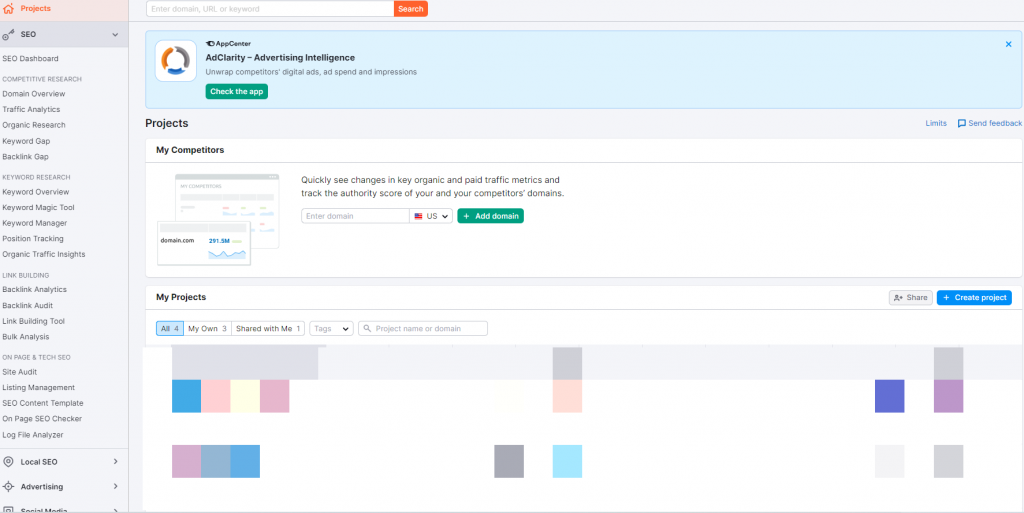
It’s also worth mentioning that Semrush is a reliable content marketing solution, as it offers plenty of tools such as SEO content templates, a content calendar, content audit, etc., which can help you level up your content marketing strategy.
Semrush pricing
Like Ahrefs, Semrush also has a forever free plan with a limited number of features. Paid plans start at $119 a month.
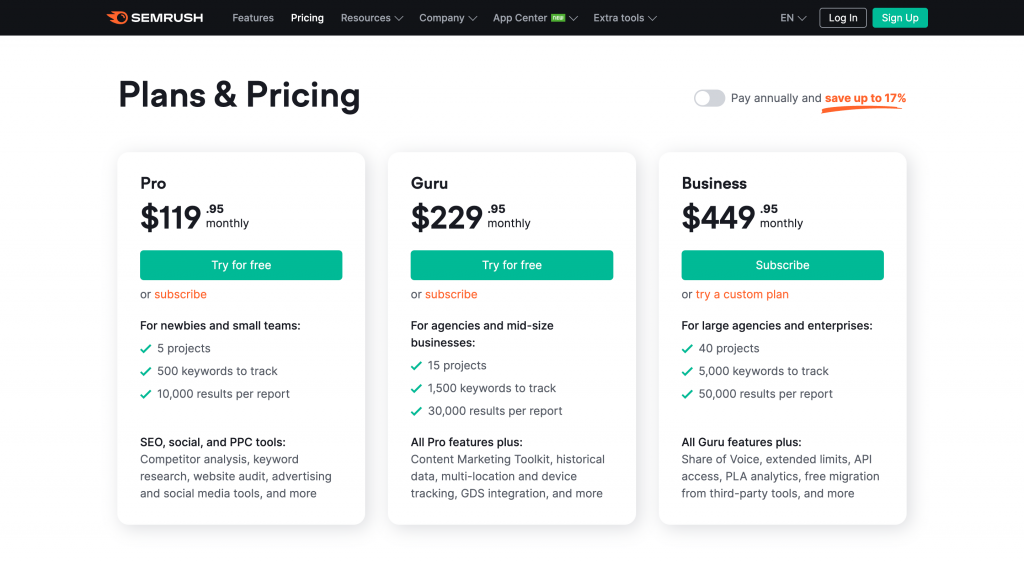
The cheapest Pro plan is perfect for small teams and newbies in digital marketing. Once your team grows, you can switch to the Guru subscription great for agencies and medium-sized businesses. The Business plan is only necessary if you run an agency and need to run large-scale campaigns.
Now, let’s take a look at the last option in the SEO category of tools for digital marketers.
SEO Tool #3: Clearscope
Clearscope is an AI-powered keyword research solution helping digital marketers make more out of their content and boost website traffic.

The platform calls itself best in class.
Why, you ask?
This statement is inspired by the system Clearscope uses to grade content. The more search terms the content piece includes, the higher the grade. It is very convenient, as you don’t have to manually search for every keyword just to make sure it’s there in the content.
Who is it for?
Clearscope is the solution for you if you want your website to rank higher in SERPs but don’t have time or capacity for extensive keyword research.
Clearscope features
Clearscope operates as a dashboard with a text editor. You can type in the keyword of interest, and the tool will collect a pool of search terms that you can later include in the text.
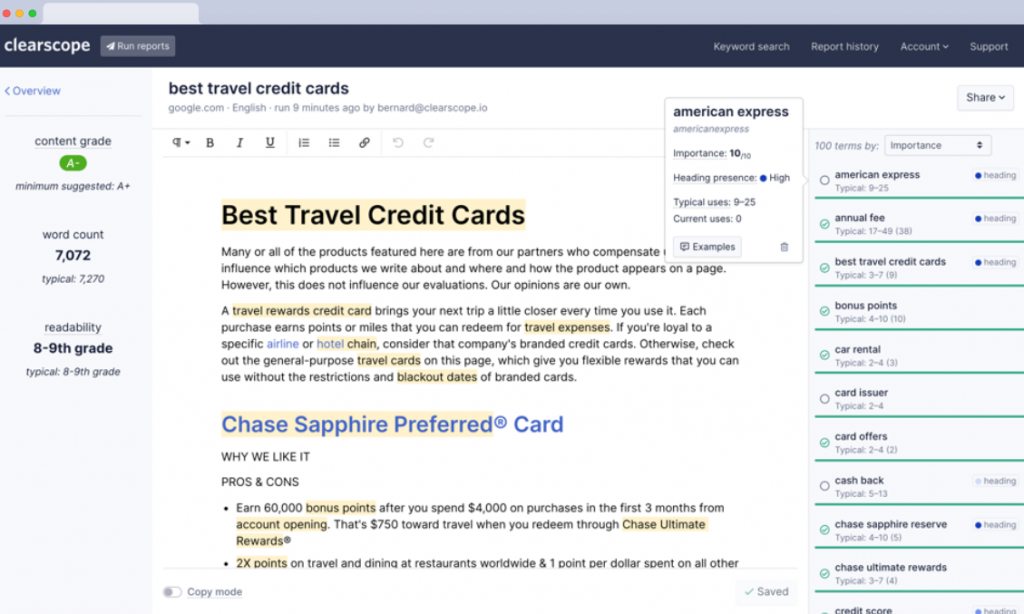
Once you paste your text into the editor, the tool will automatically grade it. Next, you can work on improving the content grade by optimizing the piece with more search terms. Later, after the content is published, you can also use Clearscope for rank tracking, SEO reporting, and competitor analysis.
Clearscope pricing
Clearscope doesn’t have a freemium, but you can schedule a call with the sales team to check out the product demo.

If you happen to like the tool, you can start with the Essential plan, which costs $179 a month – it allows 20 content reports, 100 keyword discovery credits, and three user seats. The Business subscription is more extensive and is perfect for SaaS businesses doing SEO on a scale and other businesses that want to invest in growth. The Enterprise plan is customizable and is a good fit for big SEO agencies.
Now, it’s time for our next category – solutions for paid media.
Paid Media Tools
Although the digital marketing community often primarily focuses on inbound marketing (if you don’t know what it is, check out our comparison guide on this strategy vs. ABM), paid advertising still plays a crucial role. It can significantly speed up lead generation, boost sales, and increase brand awareness.
However, this strategy can also be quite costly and requires constant monitoring to ensure the campaign performs at the highest level, and your money doesn’t go down the drain. That’s why it’s better to invest in paid media platforms, three of which we want to introduce to you today.
Let’s see what they offer.
Paid media tool #1: SpyFu
SpyFu is a web search analytics and competitive intelligence platform that helps you optimize and boost your SEO and PPC revenue.
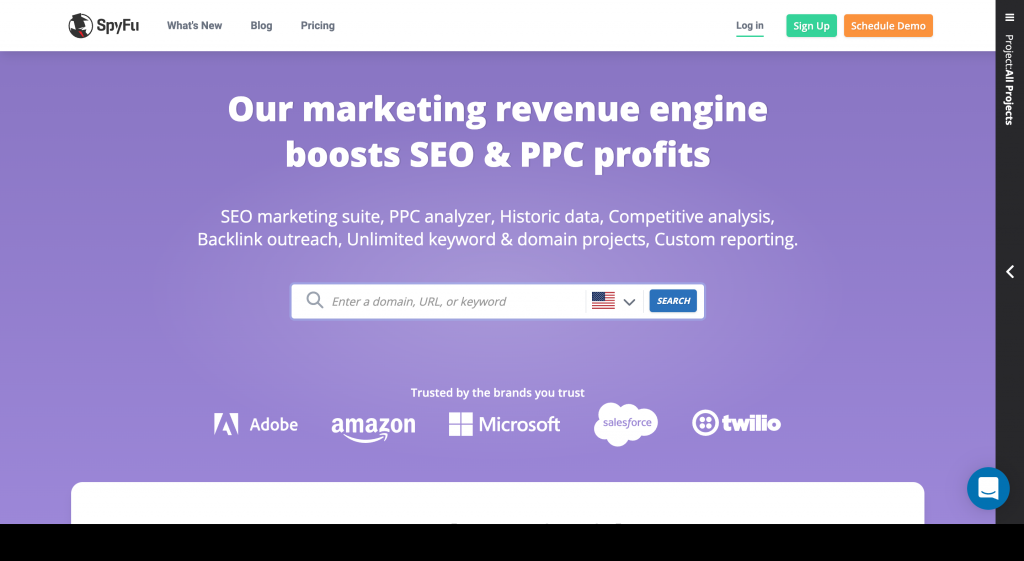
Essentially, SpyFu allows you to see the performance of a given domain, the keywords it ranks for, ads it has purchased on Google, and its top rivals to help identify its strengths and weaknesses and use this data to optimize your website’s performance.
Who is it for?
Since we’re talking about paid media, you can rely on SpyFu if you want to run a data-based advertising campaign. It provides information on your competitor’s online advertising activities and helps identify the strategy that will work best in your case.
SpyFu features
Inside SpyFu’s dashboard, you can find tools for:
- SEO (competitor analysis, backlinks builder, keyword research, rank tracking, SERP analysis)
- Competitive intel (traffic analysis, domain comparison, SEO & PPC strategies, market analysis)
- Project management (keyword grouping, backlinks outreach, etc.)
However, what interests us the most is the PPC solution, which includes:
- Google Ads Advisor
- Ad history
- Domain comparison
- Google Ads campaigns
- Competitor analysis
So, with this platform, you can get enough insights to run a successful ad campaign.
SpyFu pricing
You can start SpyFu on a free trial, but you will have to add your credit card details right away. The cheapest Basic plan costs $39 a month:
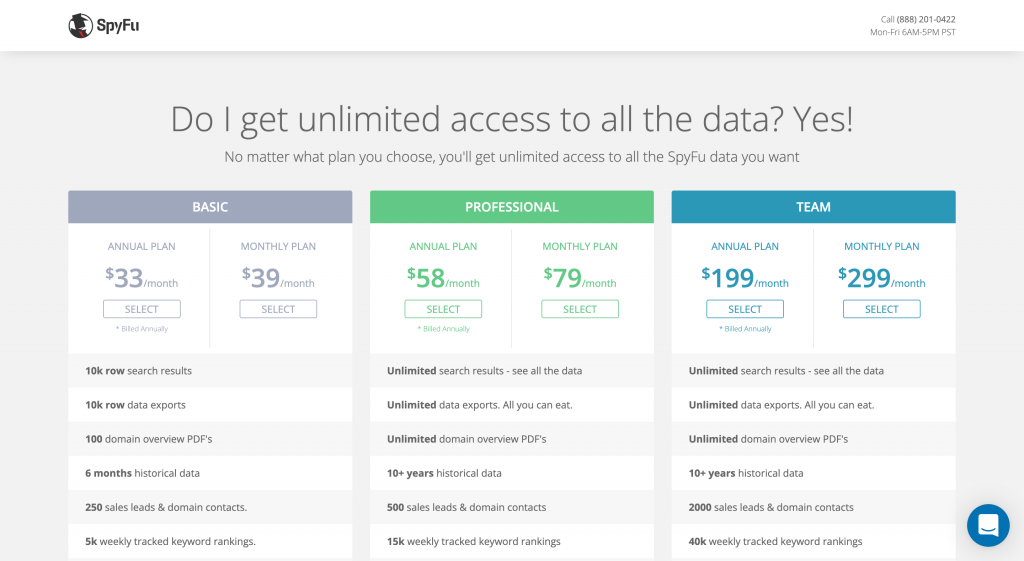
However, keep in mind that the Basic plan has limits on everything – search results, data exports, historical data, etc. If you want to increase the tool’s functionality, you can opt for the Professional or Team plans. By the way, if you choose an annual subscription, you will get a considerable discount.
Now, let’s see what our next paid media solution has to offer.
Paid media tool #2: Optmyzr
Optmyzr is an online SEM and PPC tool that helps you run an advertising campaign from A to Z. It allows you to manage ads, budgets, bids, and keywords. Advertising experts can use it to run online ads via AdWords, Microsoft, Amazon, and Meta platforms (Facebook, in particular).
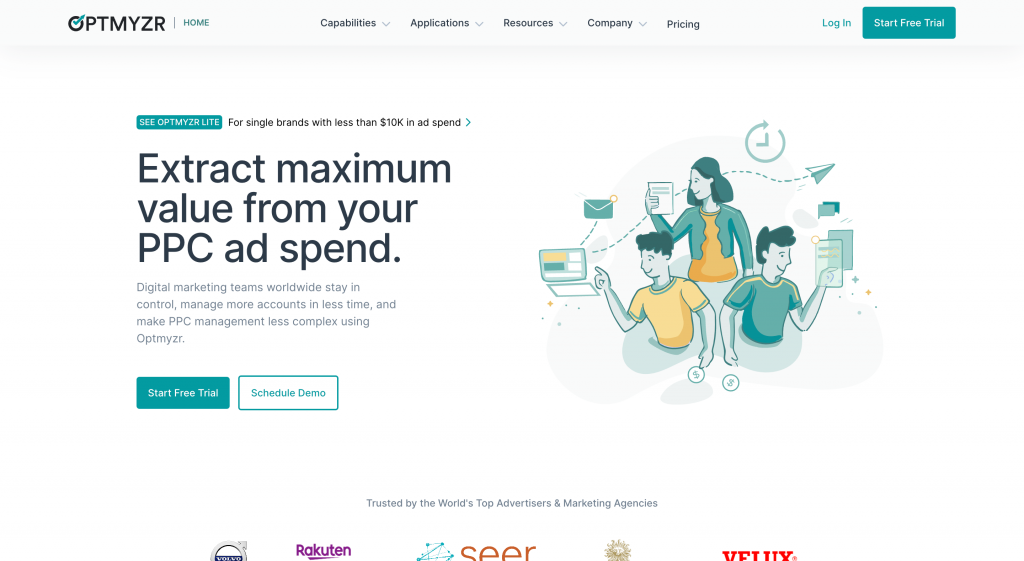
Optmyzr’s dashboard includes everything you need to run paid media campaigns, saving you a lot of time. However, its capabilities are pretty extensive, so let’s figure out who would benefit from them the most.
Who is it for?
Optmyzr is the best tool for those who want to improve the performance of their advertising efforts. So, if your ads are underperforming, you can turn to this platform for detailed reports and optimization recommendations.
Optmyzr features
Here’s the complete list of what Optmyzr has to offer:
- One-click PPC optimizations
- PPC insights
- Reports and ad monitoring
- Ad budget optimization
- Shopping ads (great for e-commerce businesses)
- Bid management (helps you place more effective bids)
- Campaign Automator (includes inventory with templates)
Speaking about ad formats, this platform allows you to manage and track search ads, shopping ads, display ads, and video ads – essentially, every type you might be interested in.
Finally, regarding the advertising platforms, Optmyzr works with the following ad engines:
- Google Ads
- Microsoft Ads
- Amazon Advertising
- Facebook Ads
- Yahoo! Japan
You can also use this platform to streamline your digital marketing team’s workflow.
Optmyzr pricing
Optmyzr has a free trial available for 14 days. Next, you will have to choose among the following plans:
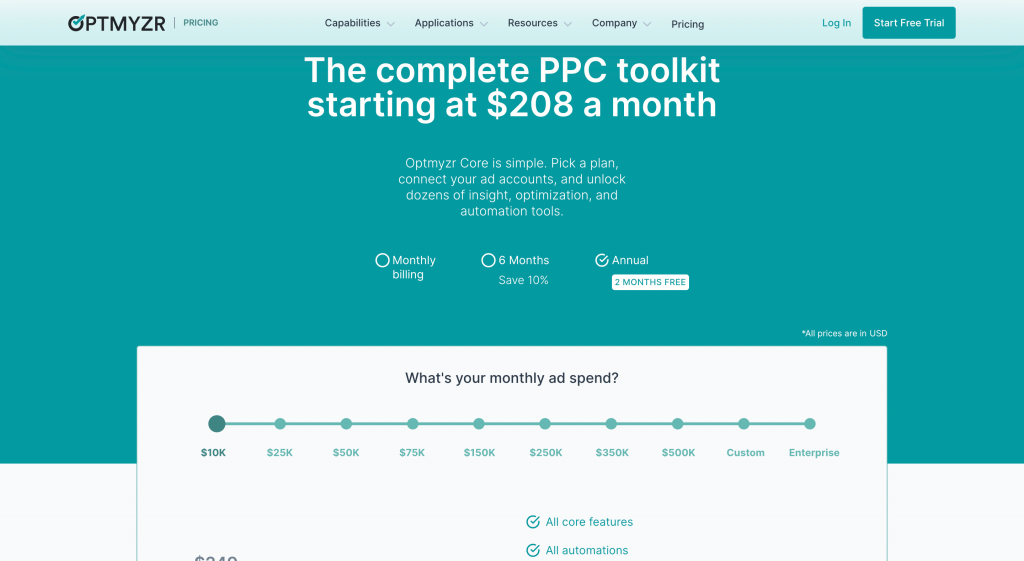
Essentially, the price per subscription will depend on your monthly ad budget. Let’s say your ad spend is no more than $10K – in this case, your plan will cost €249 a month. However, the price will drop substantially if you choose a 6-month or an annual subscription. You can also set the Custom or Enterprise budget, but you will have to negotiate the price for your plan with the sales representative.
It’s time for the last option in the paid media category.
Paid media tool #3: Optimizely
Optimizely is an online digital marketing tool that offers a stack of solutions to improve customer experience and personalization across several channels – websites, mobile apps, etc.
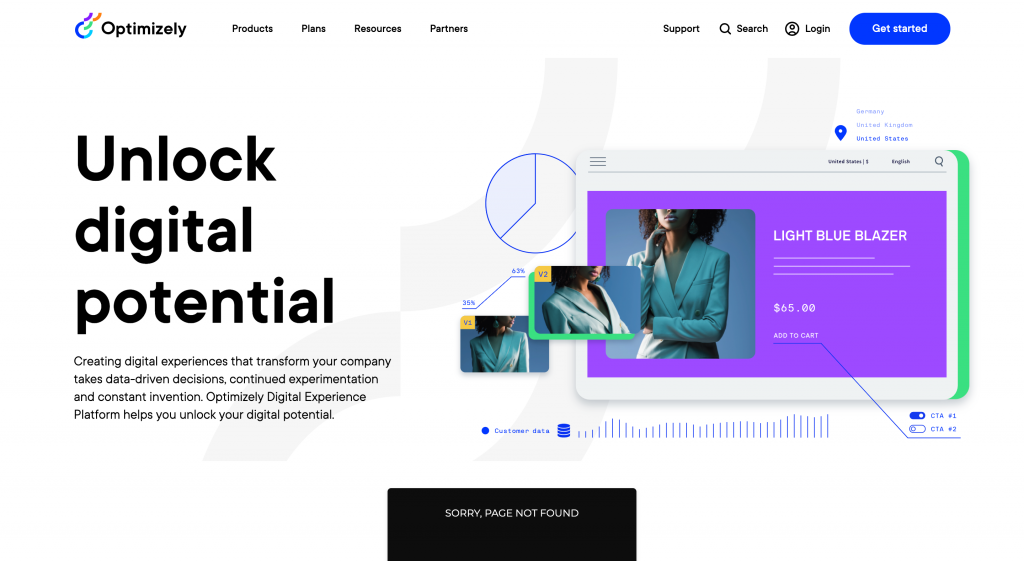
Essentially, you can use Optimizely to improve the performance of any digital marketing strategy, including paid campaigns, thanks to its features that we’re going to discuss a bit later.
Who is it for?
First and foremost, Optimizely is for companies trying to figure out what can work for them in terms of online marketing – this is an experimentation platform that provides in-depth insights and data to help you better understand your target audience’s needs and adequately address them.
Optimizely features
Let’s take a look at the Digital Experience Platform toolkit offered by Optimizely to understand how it can help with your PPC activities:
- Data visualization
- Conversion rate optimization
- Split testing
- A/B testing
- Multivariate testing
- Audience targeting
- Library of templates
- Optimization recommendations
- Visual editor (for landing pages, web forms, and ads)
- Statistical analytics
- Activity dashboard
- Campaign segmentation
- Content management
- E-commerce toolkit
As you can see, this platform includes everything necessary to create ads, choose the best-performing ones (thanks to A/B testing), launch and run campaigns, optimize their performance based on data, etc. It is indeed an all-in-one solution for your digital marketing needs.
Optimizely pricing
Optimizely is available for free with tools such as digital asset management, workflow optimization, integrated calendar, and team collaboration. Paid plans are divided into four categories:

Unfortunately, there is no information on the prices, so you’ll have to request it during the demo call with someone from the sales team.
We’re done with the paid media solutions, so let’s hover over to our next category – email marketing.
Email Marketing Tools
Let’s be honest – it’s nearly impossible to run an email campaign without marketing automation tools. You could try, but you’d just end up doing everything manually, and there are not enough hours in a day to manage all that volume of work.
So, let us introduce you to the three email marketing automation platforms that will cover most of the tasks – the only job you’ll have to do is track and optimize.
Email marketing tool #1: Mailchimp
Mailchimp is an all-in-one marketing automation platform with AI-powered tools allowing you to create and send personalized emails for better conversions, revenue, and brand recognition.
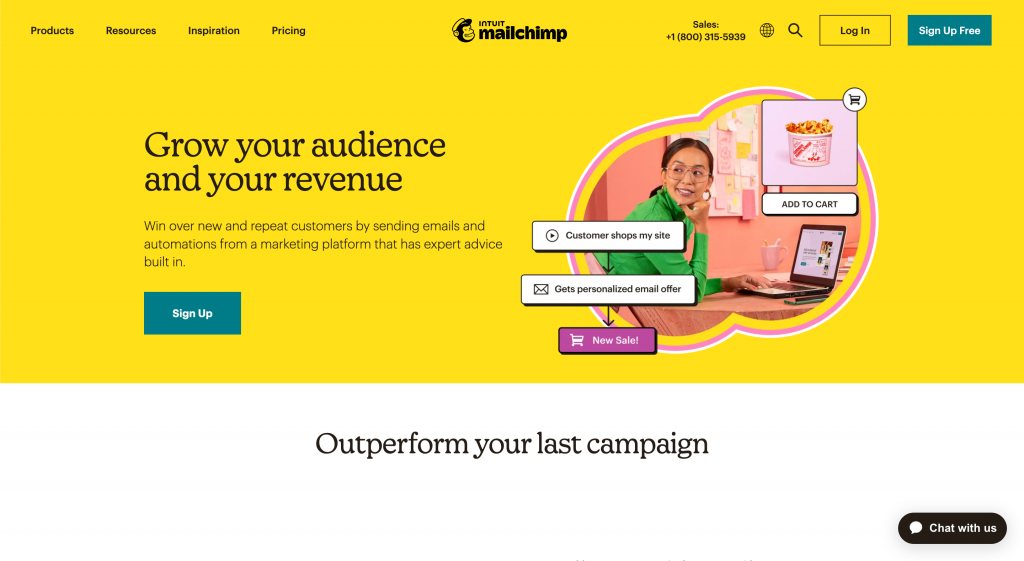
This platform has everything you need to automate your email marketing campaign – from templates to a scheduler, built-in opt-in forms, and other solutions to grow your email list, generate leads, nurture, and convert them.
Who is it for?
Small businesses would benefit from Mailchimp the most, as it allows you to run campaigns with a small contact list and gradually scale it using AI-powered optimization recommendations.
Mailchimp features
We can divide the entire Mailchimp toolkit into four parts:
- Audience Management
- Creative Tools
- Marketing Automation and Email Marketing Service
- Insights and Analytics
Each toolkit includes solutions necessary for successful email marketing – segmentation, behavioral targeting, predicted demographics, content studio, subject line helper (excellent if you want to improve CTR), campaign templates, customer journeys, A/B testing, and reporting.
You can learn more about these features in our Constant Contact vs. Mailchimp, ActiveCampaign vs. Mailchimp, and SendGrid vs. Mailchimp comparison guides.
Mailchimp pricing
Everyone interested in this service can start using it for free for an unlimited time but with a limited number of contacts (only 1000). The cheapest Essentials plan starts at $11, which is pretty affordable:
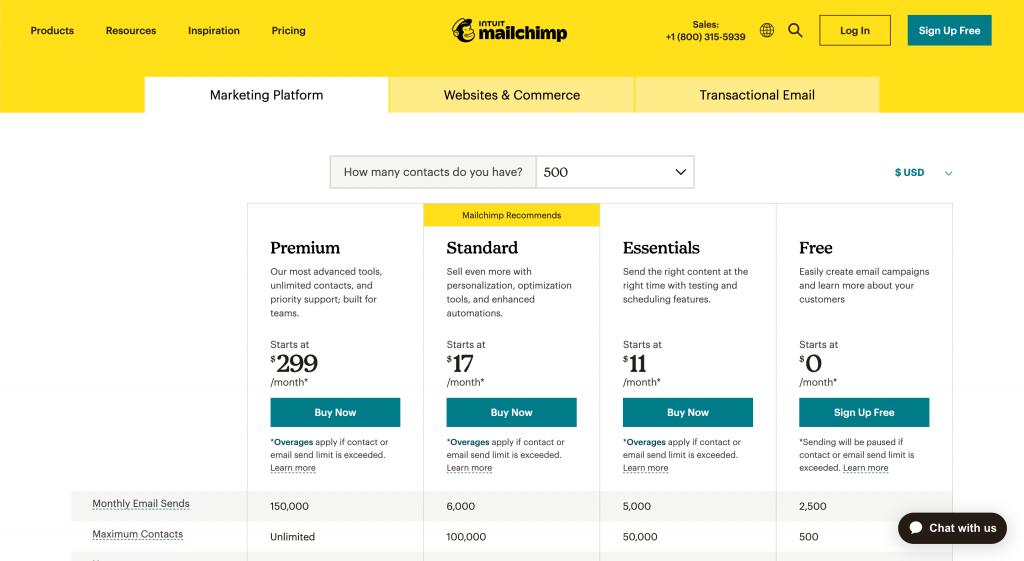
You can also increase Mailchimp’s capabilities by switching to the Standard or Premium plan, but note that the price for each subscription changes based on how many contacts you have. The more your list grows, the more you’ll have to pay.
Now, let’s see how Moosend is different from Mailchimp.
Email marketing tool #2: Moosend
Moosend is an email marketing automation service allowing you to launch and track email campaigns, manage and grow your audience, and assess the performance of your marketing efforts.
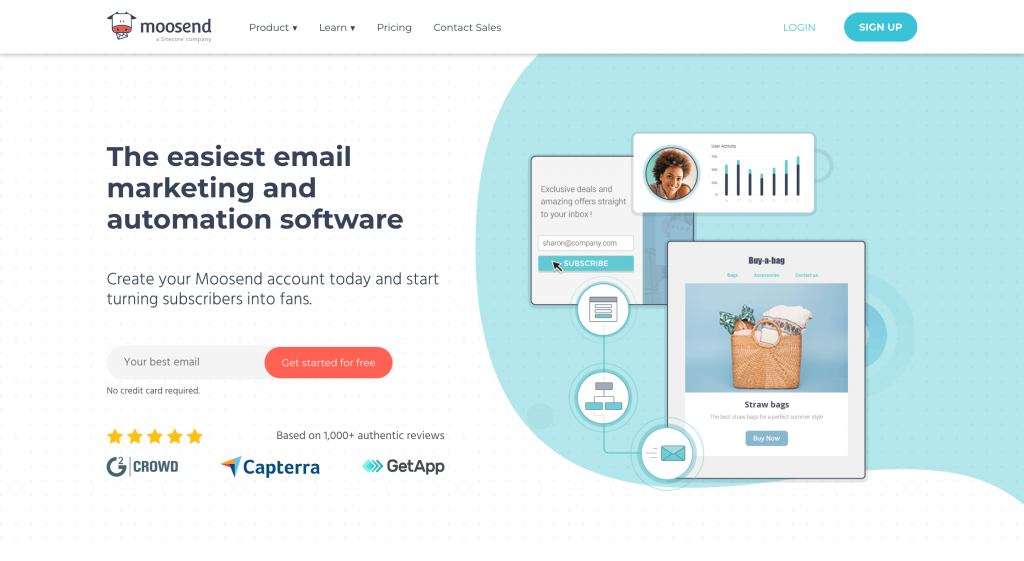
In its user-friendly dashboard, you can draft emails using the drag-and-drop editor, A/B-test them, segment your contact list, use templates, and generate reports. In other words, this tool covers everything necessary for a successful email marketing campaign.
Who is it for?
Moosend is great for a business of any size that wants to do email marketing right from the start. It’s also great for digital marketers with no experience – its platform includes an extensive knowledge base and video tutorials covering every aspect of using this tool.
Moosend features
Here’s what Moosend has to offer:
- Email marketing toolkit (templates, A/B testing, personalization, email newsletter optimization, segmentation, and reporting)
- Marketing automation toolset (workflow editor, integrations, cart abandonment, etc.)
- Personalization recommendations
- Tracking
- Reporting and Analytics (campaign overview, recipient analysis, location and device tracking, real-time reporting, etc.)
You can also take advantage of the e-commerce, CRM, CMS, lead generation, and list validation integrations. By the way, the last category of integrations is necessary to build a high-quality lead list.
Moosend pricing
The free trial is available for 30 days for everyone interested in the tool but not ready to invest. The Pro plan starts at $9 a month, but the price will depend on the size of your contact list:

If you find the Pro plan insufficient to cover your needs, you can devise a custom subscription by scheduling a call with Moosend’s sales team.
Finally, let’s talk about MailerLite and its features.
Email marketing tool #3: MailerLite
MailerLite is a marketing automation solution with tools for email marketing, website building, collecting leads, and improving e-commerce sales.
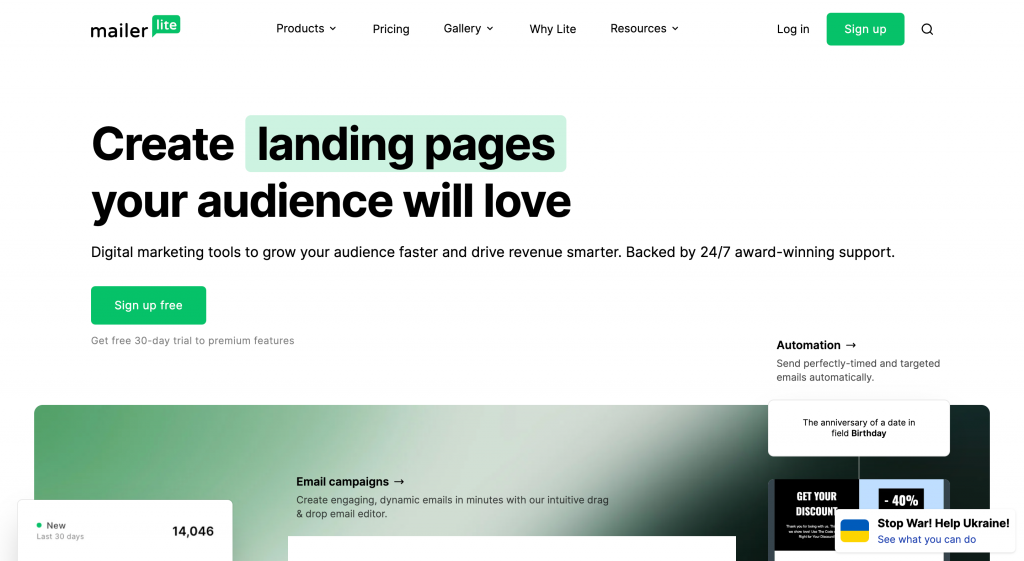
We’ve discussed this platform in more detail when comparing it to Mailchimp, but let’s quickly recap what it has to offer.
Who is it for?
MailerLite is the best tool for marketers who want to drive and nurture leads through email campaigns. It also includes additional tools for this purpose, such as pop-ups, embedded surveys, auto-resend campaigns, etc.
MailerLite features
Let’s break down MailerLite’s features into four categories:
- Email marketing (email list growth and optimization, campaign automation, newsletter editors, follow-up and transactional emails)
- Website builder (blog and landing page builder)
- Lead generation (email verifier, signup forms, etc.)
- E-commerce (integrating your online store with email marketing to increase sales)
MailerLite is also very user-friendly – it won’t take long to figure out how it works, as its UI is pretty easy to use. Plus, you’ll definitely benefit from the platform’s knowledge hub if you’re a newbie in email marketing.
MailerLite pricing
MailerLite has a forever-free plan for contact lists with up to 1000 subscribers.
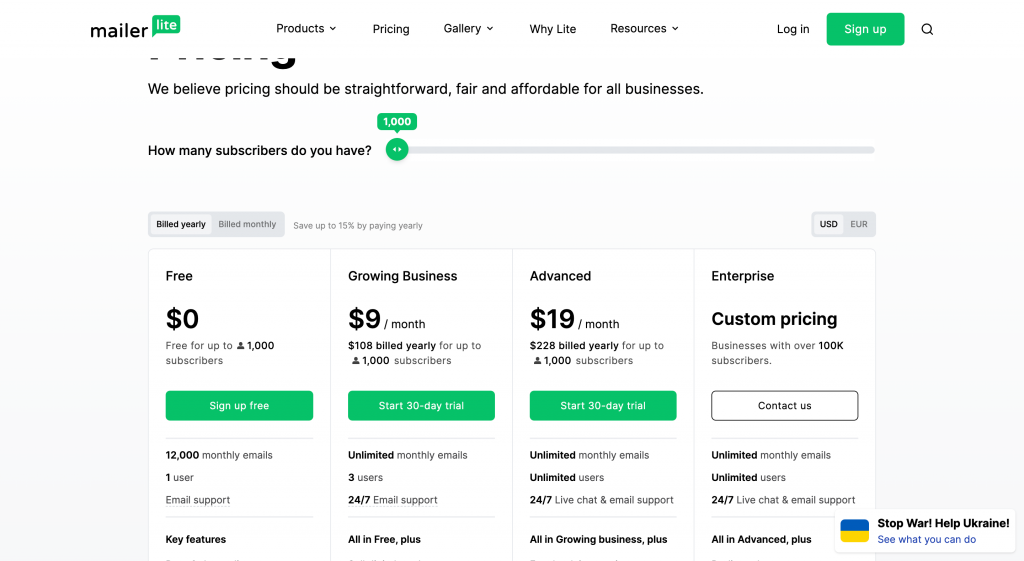
If your list is larger, you can choose between the Growing Business, Advanced, or Enterprise subscriptions – all of them have unlimited monthly emails but differ in terms of the number of users and reporting features.
Now, let’s see what tools can help you with social media marketing.
Social Media Management Tools
If you’re running a startup or a small business, you can do social media management manually, but up to a certain point. If you decide to involve ads, influencer marketing, and other related strategies, the costs of social media marketing can jump through the roof. Besides, as your business grows, so will your strategy, so it’s better to take that into account from the beginning.
That’s why let us introduce you to three social media management platforms with automation features that will save you time and money.
Social media management tool #1: Buffer
Buffer is a social media management solution covering all related tasks, from scheduling and planning to organizing social media content and tracking the results.
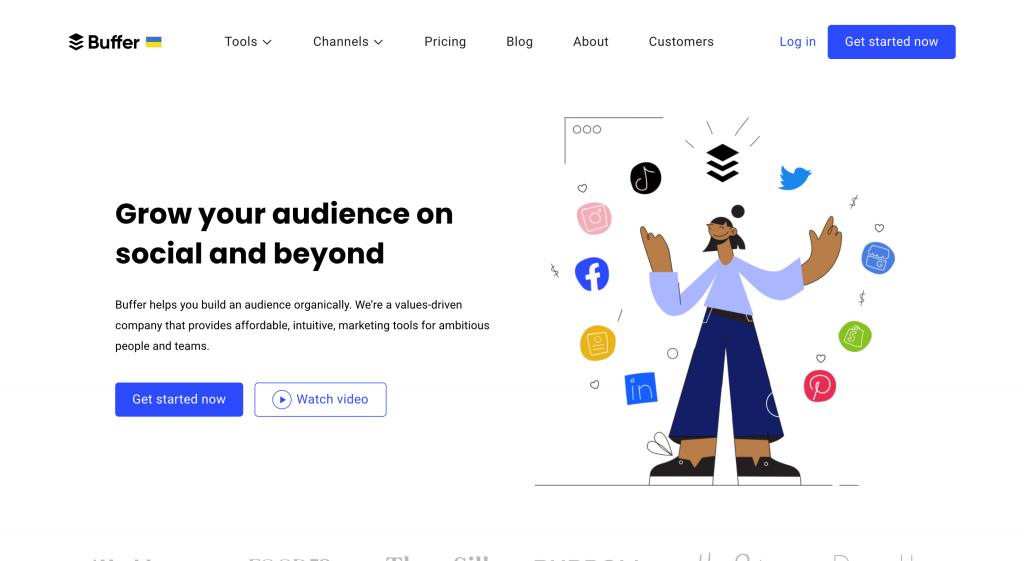
It also offers a separate tool called Buffer Analyze that helps you measure social media performance and get growth recommendations regarding reach, engagement, and sales.
We’ve already covered Buffer in some of our guides, like in this one on the best social media management tools, but let’s recap what it has to offer.
Who is it for?
Buffer can help if you spend too much time on social media management – the automation solutions it includes allow you to post on several social platforms simultaneously, schedule content for weeks ahead, and create content without leaving the dashboard.
Buffer features
The platform includes the following toolkits:
- Publishing (planning, collaborating on, and uploading content to social media)
- Analytics (tracking performance and getting data-based social media marketing tips)
- Engagement (social inbox that shows all incoming DMs from your social media accounts)
- Start page (a landing page builder)
Buffer can connect your social profiles on Facebook, Google My Business, Instagram, LinkedIn, Pinterest, TikTok, Shopify, and Twitter.
Buffer pricing
You can start using Buffer for free – its freemium includes basic publishing tools, a landing page builder, and some other essentials.
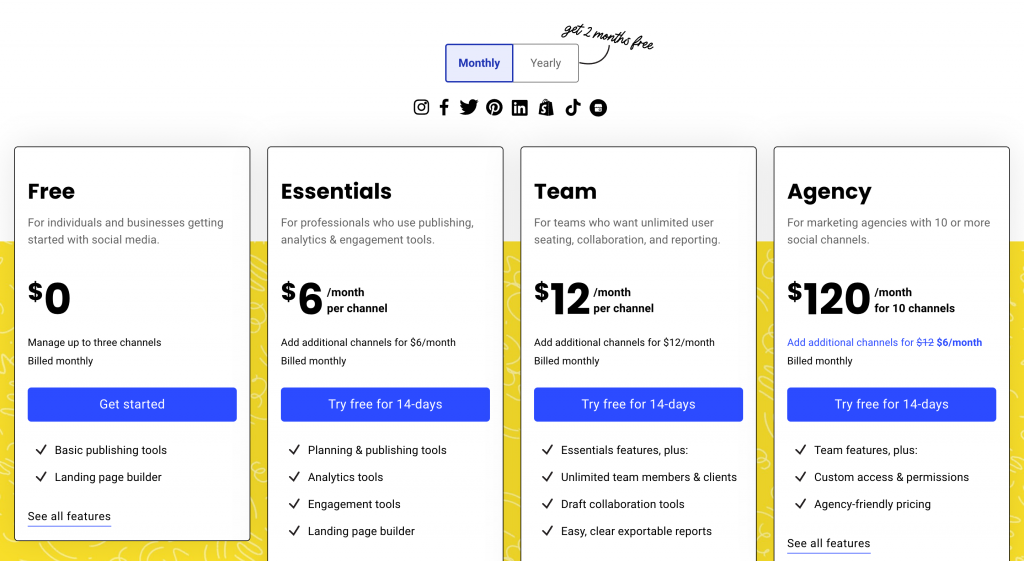
If you find the free plan too limited, you can opt for the Essentials, Team, or Agency plan – all of them are quite affordable, but you should choose the one based on your business type and social media strategy size.
Next comes one of Buffer’s major competitors – Hootsuite.
Social media management tool #2: Hootsuite
Hootsuite is a well-known social media management and CRM tool that helps you organize your social media presence and boost your strategy’s performance.
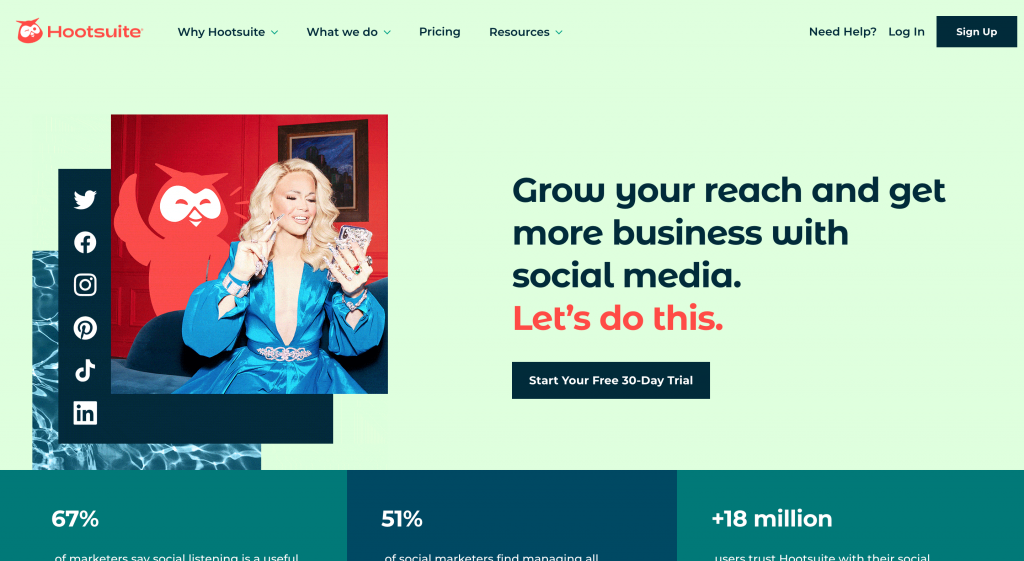
We’ve already covered Hootsuite in many of our guides, such as these comparison articles with Later and Buffer, but let’s go through its main capabilities one more time.
Who is it for?
Hootsuite is the best solution if you need help with managing both organic and paid social and tracking customer conversations in one place.
Hootsuite features
The core toolkit offered by this platform includes:
- Publishing and scheduling (social media calendar)
- Customer engagement (social inbox)
- Activity monitoring (competitor analysis and brand mentions)
- Analytics and reporting
You can also connect Hootsuite’s additional tools, such as:
- Hootsuite Amplify (for employee advocacy programs)
- Sparkcentral (allows creating a social media helpdesk platform)
- AdEspresso (helpful in Facebook Ads campaigns)
- Hootsuite Insights (tracks social media trends and conversations happening in real-time)
- Hootsuite Impact (helps understand the revenue generated via social media activities)
- Hootsuite Social advertising (optimizes your social ads based on your budget)
This platform allows connecting social profiles on such social media platforms as TikTok, Twitter, Facebook, LinkedIn, Pinterest, and YouTube.
Hootsuite pricing
Good news – Hootsuite has a free trial for everyone interested. The Professional plan that includes one user, ten social media accounts, unlimited posts, scheduling, and the social inbox feature costs $49 a month.
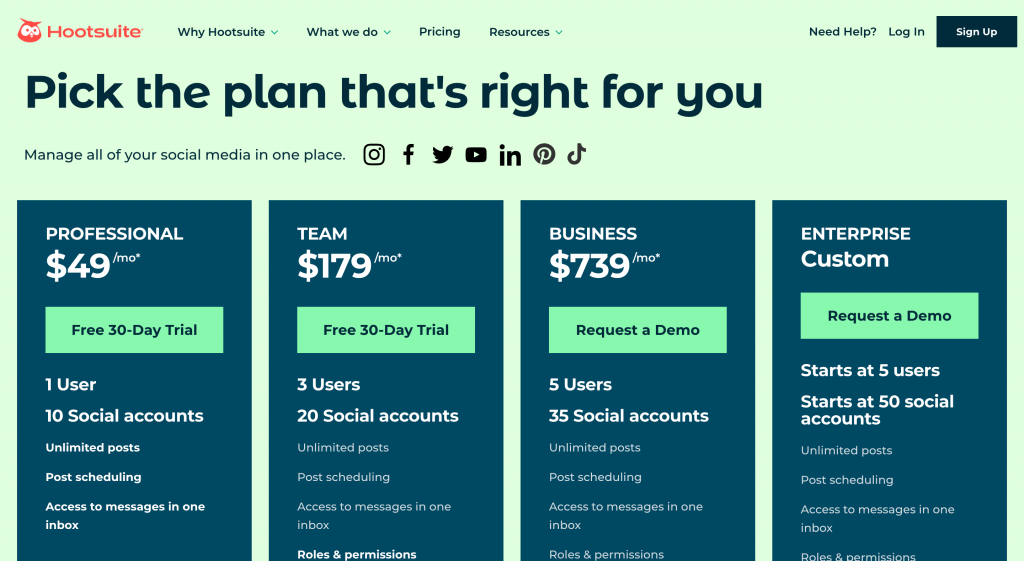
If your social media marketing team has more than one person, you should consider the Team or Business plans. However, if they don’t cover your needs feature-wise, you can request a demo and discuss a custom plan with a sales rep.
By the way, if you find Hootsuite a bit too expensive for your current budget, we have a list of eight more affordable alternatives.
Now, let’s see what the last tool on this list has to offer.
Social media management tool #3: Sprout Social
Sprout Social is a social media marketing software that helps you improve your social media strategy based on data-driven insights.
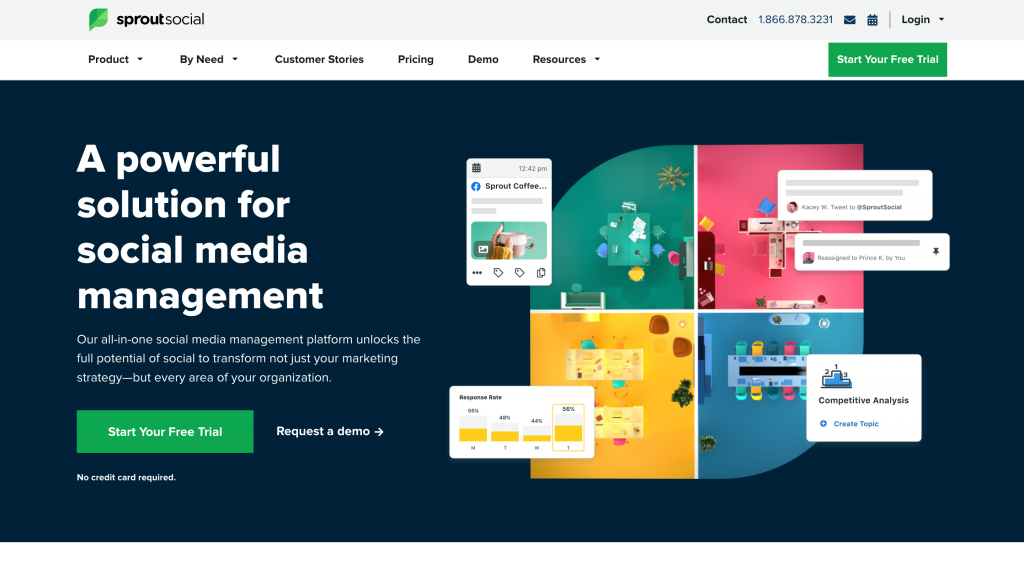
We’ve also mentioned this tool in many of our comparison guides, for instance, with Hootsuite, since it’s one of the most reliable and well-known solutions for social media managers. Let’s recap its functionalities once again.
Who is it for?
Sprout Social’s strongest suit is reporting and analytics. So, if you want to make data-driven decisions when it comes to your social media campaigns, this platform is exactly what you need.
Sprout Social features
Sprout Social’s main toolkit doesn’t differ much from its rivals:
- Engagement (a unified social inbox)
- Publishing and scheduling (a social media calendar and collaboration tools for marketing team members)
- Analytics (social data)
- Listening (brand monitoring and social media trends)
We also recommend taking advantage of Bambu, Sprout Social’s platform allowing your employees to share curated content via their social media profiles.
Sprout Social pricing
There is a free trial and a demo call option available for all interested users.
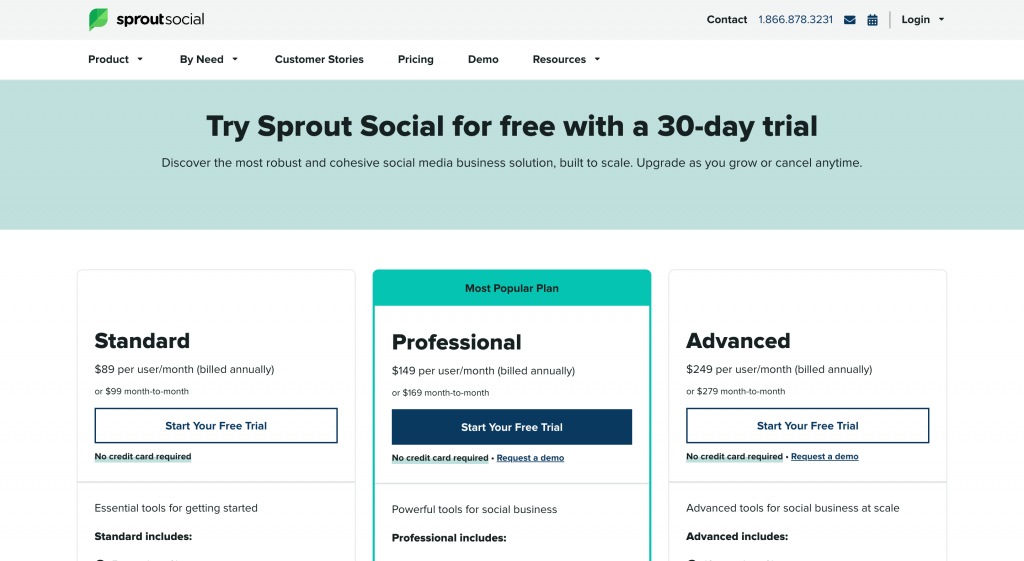
The cheapest Standard plan costs $89 a month (if you choose annual billing) and allows connecting up to 5 social media accounts, plus publishing, scheduling, analytics tools, etc. The Professional and Advanced plans are for big social media teams and agencies helping multiple clients with their SMM activities.
With the social media management software clear, let’s move on to solutions for digital marketing analytics.
Analytics Tools
Analytics and reporting are the backbone of a successful digital marketing strategy. When the data is scarce and incorrect, it can cause huge mishaps and even lead your campaigns to disaster.
That’s why we’ve put together the list of three analytics tools that will help you collect, interpret, and properly use data to improve your online performance. Some of them we’ve already covered in our Top Inbound Marketing Tools article, but let’s revisit their capabilities.
Analytics tool #1: Kissmetrics
Kissmetrics is an analytics software that crawls your website and apps to find data you can use to improve customer engagement and overall site performance.

This platform offers two toolkits – for SaaS and e-commerce. We will take a look at them after discussing the best use case for this software.
Who is it for?
You should go for Kissmetrics if you want to gain more insights on why your website doesn’t perform as expected, why you’re losing visitors, don’t get enough traffic, etc. The same goes for enterprise apps – you can use Kissmetrics to study their performance.
Kissmetrics features
As we mentioned, Kissmetrics has toolkits for SaaS and e-commerce. So, let’s break down its features accordingly.
SaaS businesses can collect the data on:
- New trial subscriptions
- New email subscriptions
- Churns
- Trial to signup conversion rates
- Monthly recurring revenue
- The source bringing the most new users
- Features users engage with the most
- Customer lifetime value
This is only a fraction of what Kissmetrics can do for you. The platform can also tell you when it’s the right time to launch a new feature.
Speaking of e-commerce, here’s what online business owners can do with this software:
- Collect data on total sales, revenue, visitors, conversion rate, etc.
- Identify the people who spent the most money with your business.
- See if the first-time and repeat customer population is growing or not.
- Check out your most viewed and purchased products.
- Pinpoint the most popular discount offers.
Again, these are just a few examples – the list of analytics reports is pretty extensive and covers all e-commerce data needs from A to Z.
Kissmetrics pricing for SaaS
Since SaaS and e-commerce get different Kissmetrics toolkits, the pricing will also be different. The cheapest Silver plan in the SaaS category costs $299 if billed annually.
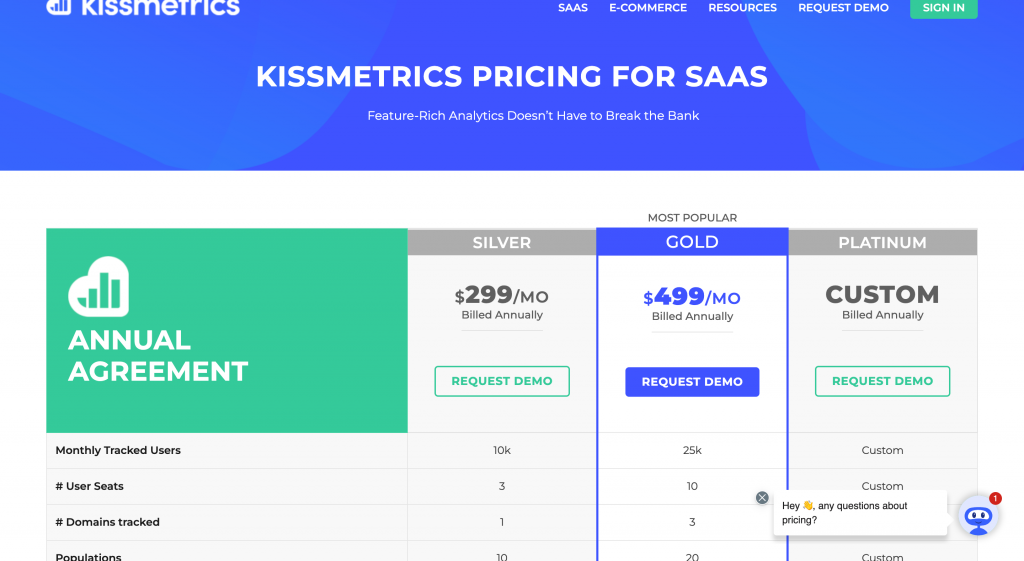
The Gold subscription is a bit more extended, particularly in terms of monthly tracked users and user seats. However, you can get even more capabilities by creating a Platinum custom plan. Unfortunately, none of these subscriptions are available via a free trial, so you will have to schedule a demo to check out the tool.
Kissmetrics pricing for e-commerce
The prices are pretty much the same for the e-commerce toolkit:
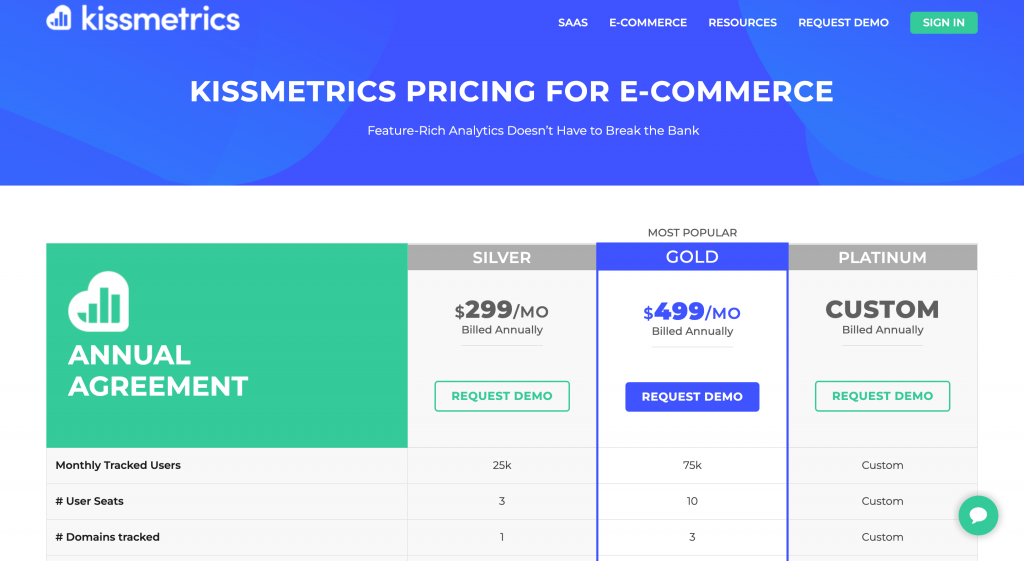
The main differences are in monthly tracked users, the number of seats, domains tracked, and populations. The Silver plan also doesn’t include some reports, such as A/B testing, revenue, cohort, and SQL.
The next tool on our list helps collect feedback.
Analytics tool #2: Hotjar
Hotjar is an online digital marketing platform that helps gather feedback through surveys and in real-time using heatmaps and recordings.

The platform’s main goal is to help you understand user behavior and apply this data to drive better experiences with your brand.
Who is it for?
Product teams will benefit from this solution the most since it shows how customers really feel about the brand and what it offers. This data is essential for brand-consumer relationships as well as customer loyalty.
Hotjar features
Hotjar’s platform can be divided into the following sections:
- Heatmaps (visualize consumer behavior)
- Recordings (map the entire customer journey and watch user behavior change in real-time)
- Feedback (gather both positive and negative reviews from the web)
- Surveys (poll your customers)
Speaking about surveys, you will also find many handy templates to speed up this task. Besides, Hotjar has many helpful integrations, such as Slack, Trello, Google Analytics, Zapier, HubSpot, Shopify, WordPress, etc.
Hotjar pricing
Excellent news – Hotjar is available for free with features limited to 1,050 sessions a month, automatic data capture, and heatmaps.
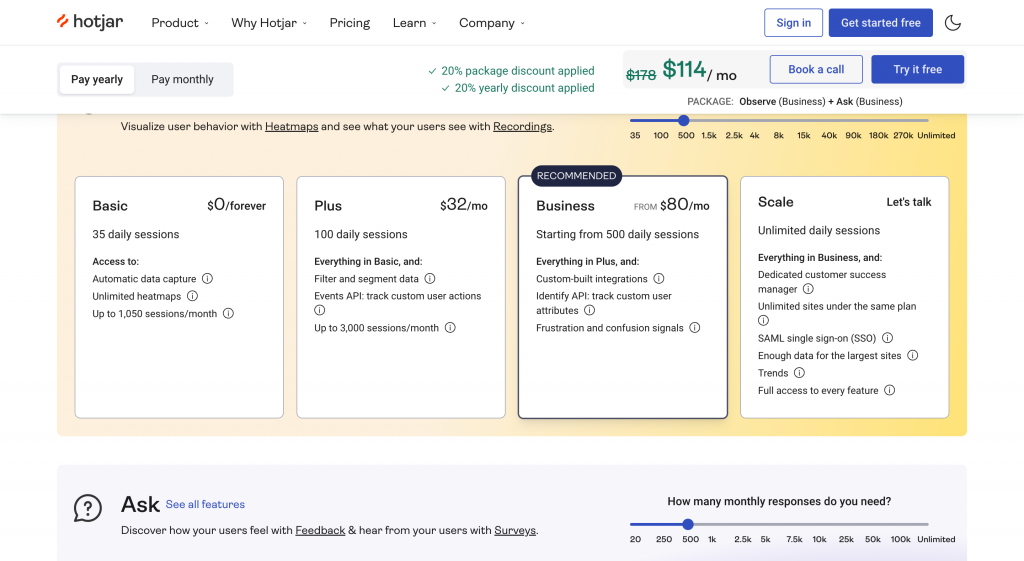
You can also choose between the paid Plus, Business, and Scale plans. The last one is customizable, so you’ll have to request a demo with the sales team.
Off to the final solution on our list of analytics tools.
Analytics tool #3: Plerdy
Plerdy is a set of CRO and SEO tools that help you track and convert your website visitors into customers.
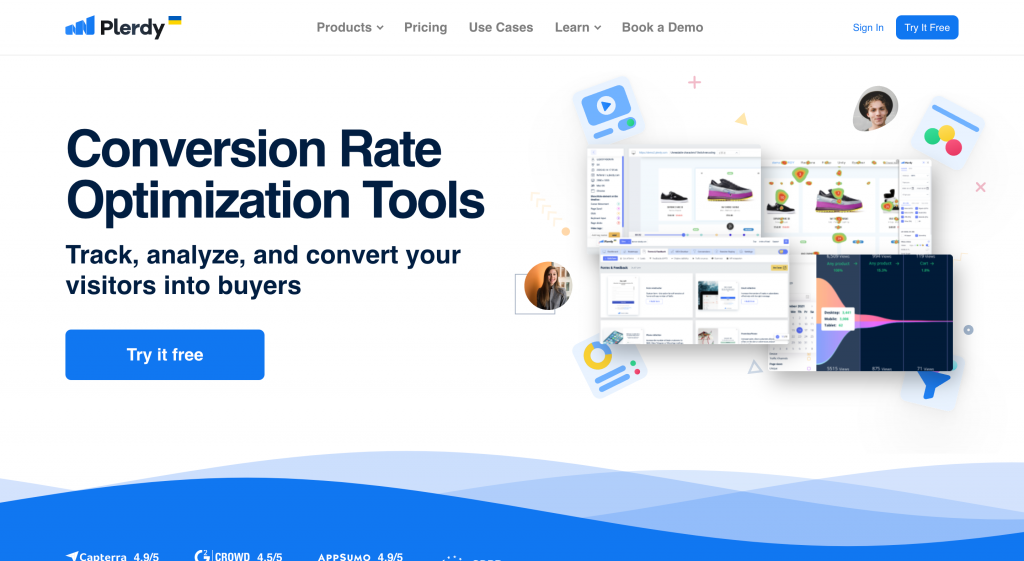
Essentially, this solution helps you create an effective sales funnel, from capturing a lead to nurturing it into a buyer.
Who is it for?
Choose Plerdy if you’re struggling with conversions – it helps you understand customer behavior to the tee, even how far they scroll down your pages and why they bounce.
Plerdy features
Plerdy offers eight products to its users:
- Heatmaps (you can see all website clicks recorded in real-time)
- SEO checker (collects important SEO tags on your site)
- Session replay (shows how your visitors behave on the website)
- Even tracking (synchronizes with Google Analytics to collect data from all site events)
- Pop-up forms (captures leads and gathers data on prospects)
- Sales performance (each item on the website gets purchase information)
- Conversion funnel (see which pages visitors ignore)
- Net performer score (a tool to collect feedback)
All in all, it’s a good tool with the functionality fit for any business, from SaaS to e-commerce.
Plerdy pricing
Plerdy has a forever free plan, but there’s a limit on pageviews, heatmaps, and SEO audit.

All plans, from the cheapest Start to Business and Premium subscriptions, are pretty affordable, and you can even get a discount if you choose the annual billing format.
Since we touched upon lead generation when discussing the last tool, let’s dedicate our next section to the platforms that help you capture potential customers.
Lead Capture Tools
Generating leads is one of the core tasks of a digital marketer. Growing the list of prospects is a continuous activity, which is also pretty time-consuming.
Thus, let us share the three effective lead capture solutions that will help you attract more MQLs and turn them into buyers.
Lead capture tool #1: OptinMonster
Optinmonster is an online lead capture platform that helps you grow and monetize your website traffic, expand your email list, and optimize conversions.
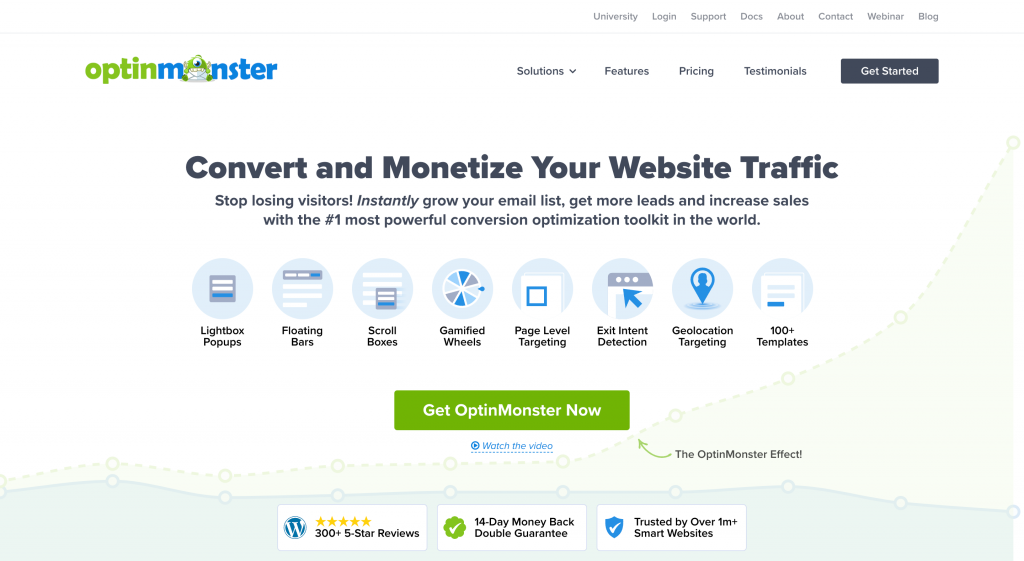
Basically, this digital tool assists you with creating engaging lead magnets to collect information about prospects and then use it to generate personalized offers.
Who is it for?
Go for OptinMonster if you see that you’re losing visitors who could potentially become buyers, as it includes tools to catch their attention with a lucrative offer and boost their interest in your brand.
OptinMonster features
The OptinMonster’s main feature is a drag-and-drop lead magnet builder which you can use to create:
- Pop-ups with a mobile-friendly interface
- Yes/No forms
- Floating bars
- Scrolled boxes
- Gamified wheels
- Full-screen welcome mats
- Countdown timers
- Sidebar forms
- Coupon wheel opt-ins
- Playbooks
Next, the tool helps you do list segmentation, perform A/B testing, run conversion analytics, and automate real-time customer behavior to improve your lead nurturing strategy and get more buyers.
OptinMonster pricing
Unfortunately, you cannot try OptinMonster for free, and you have to provide your credit card details right away. However, all plans are very affordable:
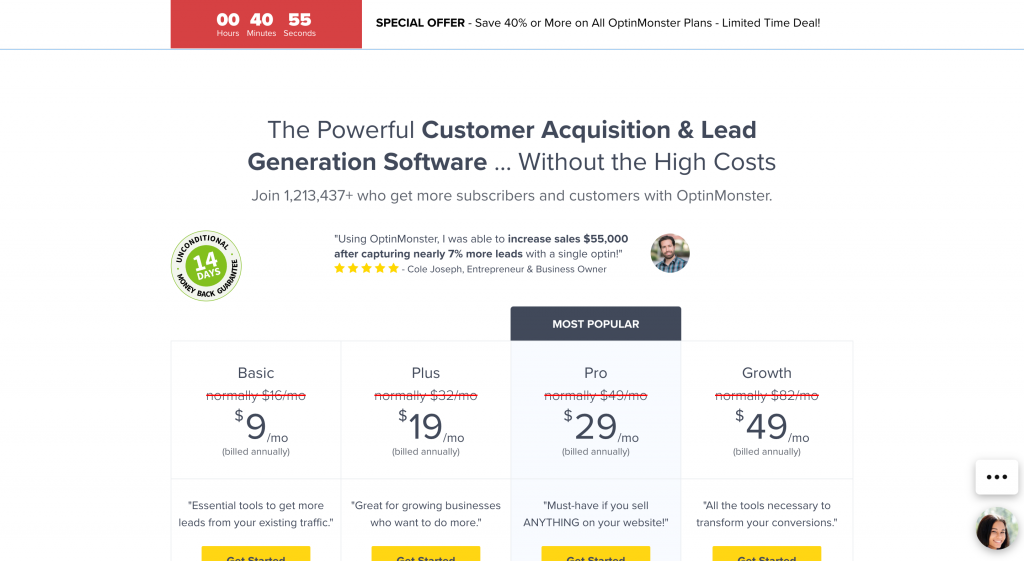
The Plus, Pro, and Growth sites are better options if you have more than one website. The Growth subscription is perfect for digital marketing agencies, as it includes extended analytics and reporting features.
The next tool on our list has similar capabilities to OptinMonster.
Lead capture tool #2: OptiMonk
OptiMonk is a lead generation solution that helps you create personalized lead magnets to drive more high-quality leads.
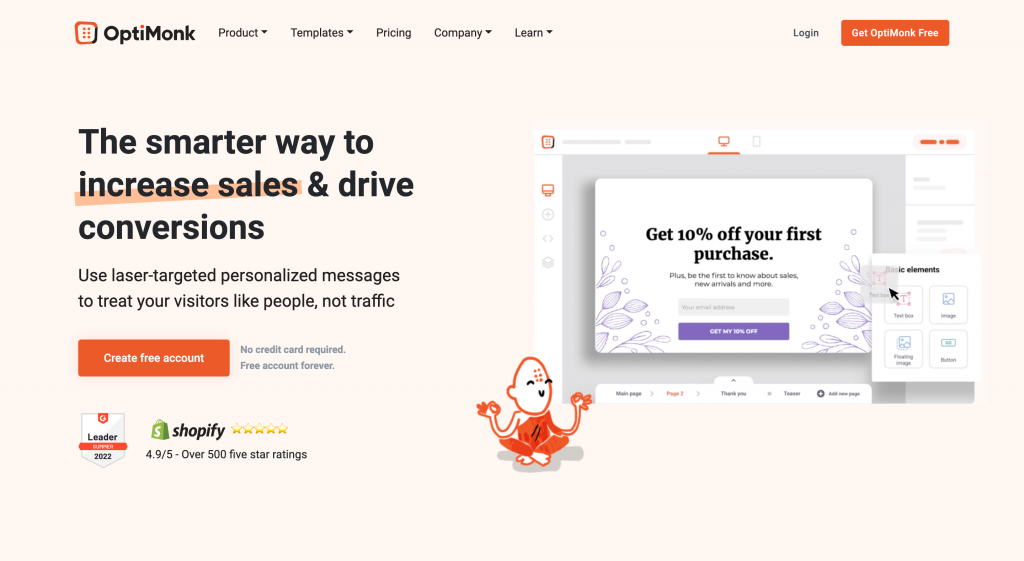
This platform also can collect customer feedback, which is necessary if you want to boost your website experience.
Who is it for?
OptiMonk is the right choice for digital marketers who don’t have time to mess around with lead magnets and want to create super-personalized ones from the start.
OptiMonk features
Aside from the extensive list of lead magnets, OptiMonk offers its users the following features:
- Triggering (monitors visitor behavior and sends you a notification when they perform a specific action)
- Targeting (supplies you with personalization opportunities)
- Design and customization (helps create eye-catching lead capture forms)
- Conversion tools (includes personalized product recommendations, A/B testing, etc.)
There’s also a comprehensive list of integrations with Google Analytics, Google Search Console, CRM, CMS, and other platforms.
OptiMonk pricing
OptiMonk is available for free, but this plan doesn’t have access to A/B testing, custom variables, and other features. The paid plans start at $29 a month.

The Essential plan is perfect for small businesses, while the Growth and Premium plans are a better fit for mid-size and large ventures. Agencies will benefit from the Master subscription, which has customizable pricing.
Now, let’s see what the remaining tool has in store.
Lead capture tool #3: Leadpages
Leadpages is an online lead magnet builder allowing you to create websites, landing pages, pop-ups, etc.

This platform includes an easy-to-use intuitive dashboard, which you can use to build any lead capture form without the knowledge of coding or web design.
Who is it for?
Leadpages mainly is a digital marketing tool for small businesses, helping them create high-converting websites, attract potential buyers and turn them into loyal customers.
Leadpages features
This tool helps you build the following forms for lead generation:
- Websites
- Landing pages
- Pop-ups
- Alert bars
- Checkouts
All users can also take advantage of the template library, test their forms, and, once they are up, generate analytics to track their performance. Besides, you can use the tool called Leadmeter, which shows the data on conversions in real-time.
Leadpages pricing
It’s possible to start using Leadpages for free for 14 days. Next, you can choose between two subscription plans.
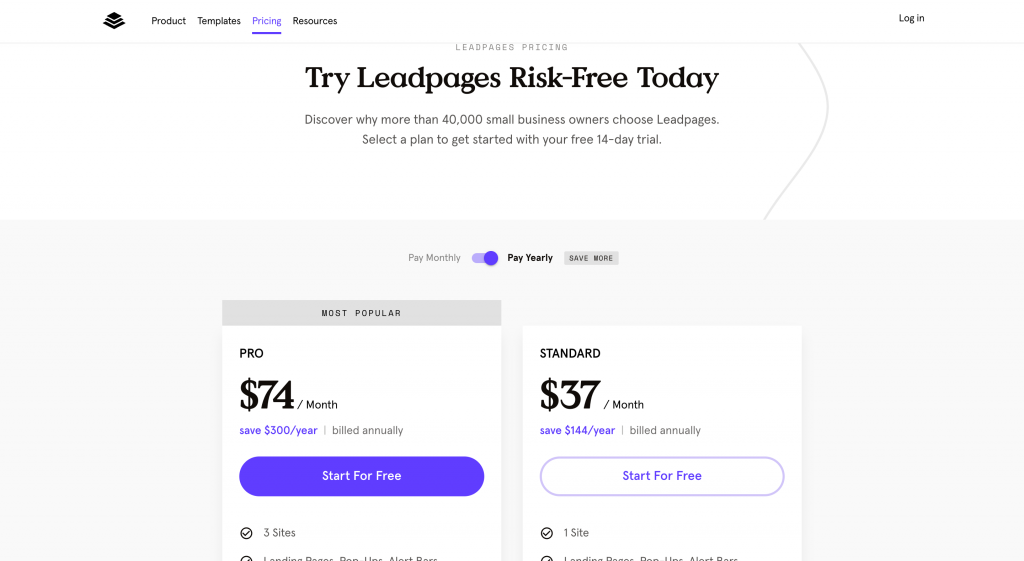
The main differences between the Standard and Pro plans lie in the number of sites you can create and track, the availability of checkout forms (the Standard subscription doesn’t include them), and some analytics tools. You can also add other features to these plans by contacting the sales rep.
Now, it’s time for the final category – tools that help you automate the creative side of your digital marketing strategy.
Design & Creative Tools
Content creation in digital marketing is not just about writing; it’s also about visual content, which plays a crucial role in engagement. For instance, a Facebook post with an image gets 2.3 times more engagement than the one without.
However, creating visuals takes a lot of time. Apart from that, not everyone is a gifted artist or has graphic design skills. If you can relate, then having the following three design tools in your arsenal is a must.
Design & creative tool #1: Canva
Canva is an online editor with a toolkit to create visual content, including presentations, banners, social media posts of all formats, infographics, etc.
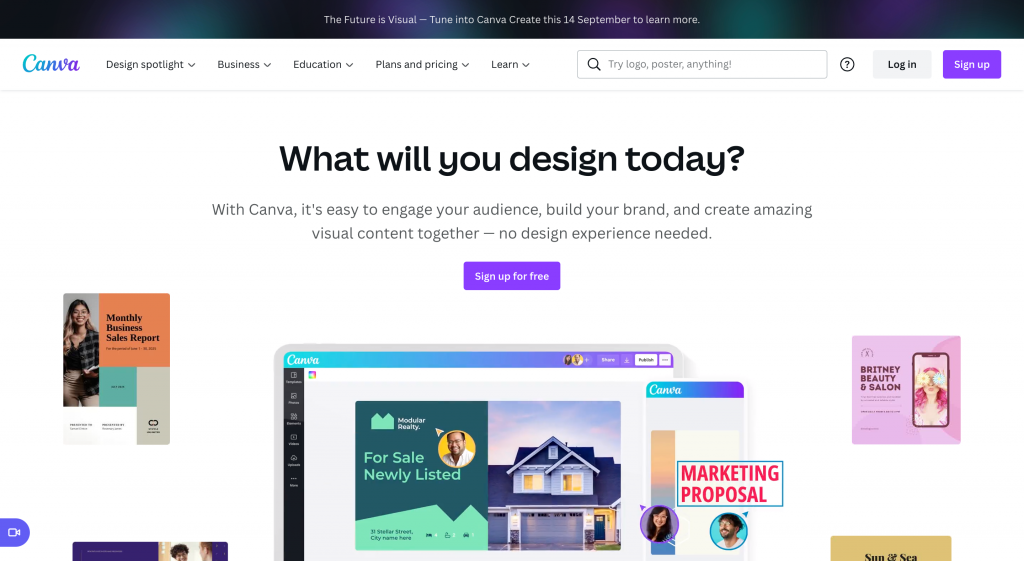
Essentially, Canva offers a large library of templates for all purposes, plus some tools to customize them. As a result, you can use it to craft any visual without graphic design skills.
Who is it for?
You can count on Canva if you want to add more visuals to your content marketing strategy but don’t have time to create them yourself – the platform has many pre-made templates you can customize in a couple of clicks.
Canva features
We can break down Canva’s toolkit into the following categories:
- Template creation (drag-and-drop editor, stock image library, etc.)
- Design and editing tools
- Ad management
- Design (layout editor, publishing formats, etc.)
- File storage
You can also use the platform’s content calendar to plan your posts across social media and other marketing channels.
Canva pricing
Canva is available for free, although access to the template library is considerably limited with this version. The Canva Pro plan costs $119.99 a month.
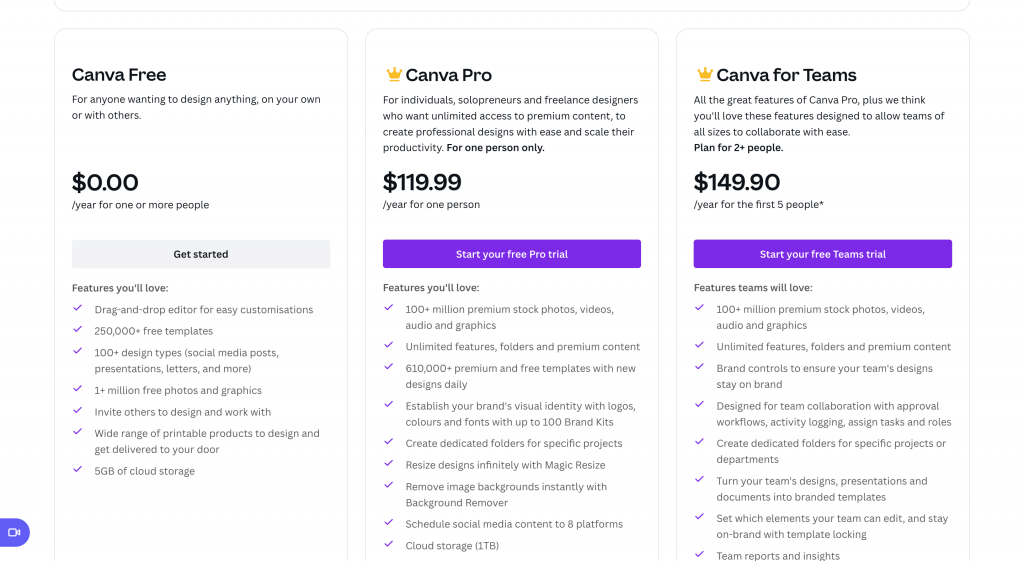
The cheapest subscription is best for a team of one. However, if you have two and more people working on content, consider the Canva for Teams option – the price difference is insignificant, but the set of features is more extended.
Let’s see what the next tool has in store.
Design & creative tool #2: Visme
Visme is an all-in-one platform for companies to create branded content – presentations, data visualizations, and other documents.
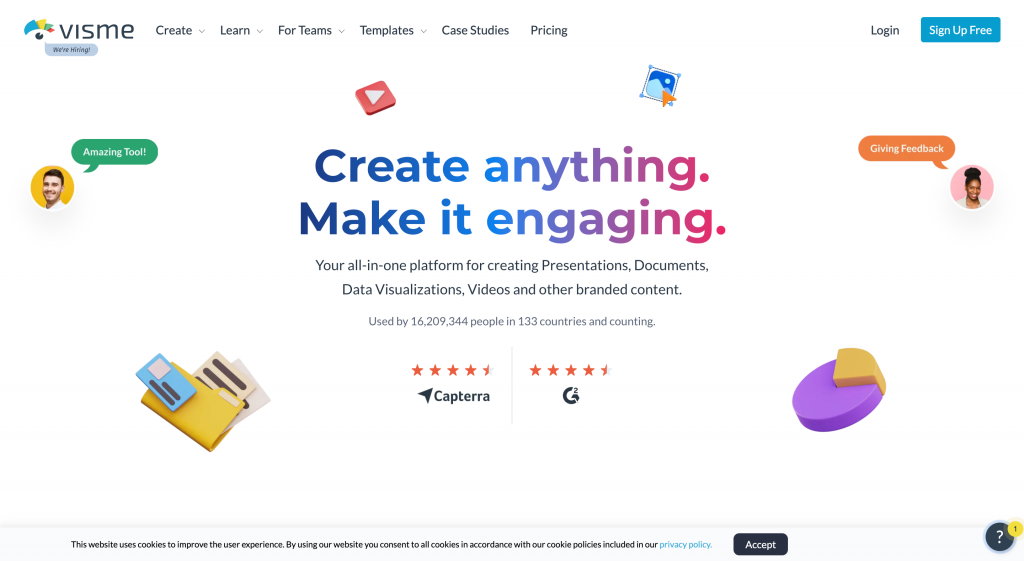
The functionality here is similar to Canva – Visme is a drag-and-drop editor with a set of templates and other visual assets to help you diversify your content strategy.
Who is it for?
Visme is a great tool if you want to create your branding strategy from scratch and need a solution to help you do it correctly from the start and consistently throughout all channels.
Visme features
The platform offers the following toolkits for digital creators and businesses:
- Platform content (template library, charts, template creator, etc.)
- Reports (dashboards, analytics)
- Basic toolkit (slide design, presenter tools, etc.)
Visme also has additional functionality that includes messaging and cloud storage.
Visme pricing
Like Canva, Visme is also available for free, with 100 MB storage and limited templates and content assets. The most affordable Personal plan starts at $12.25 a month.
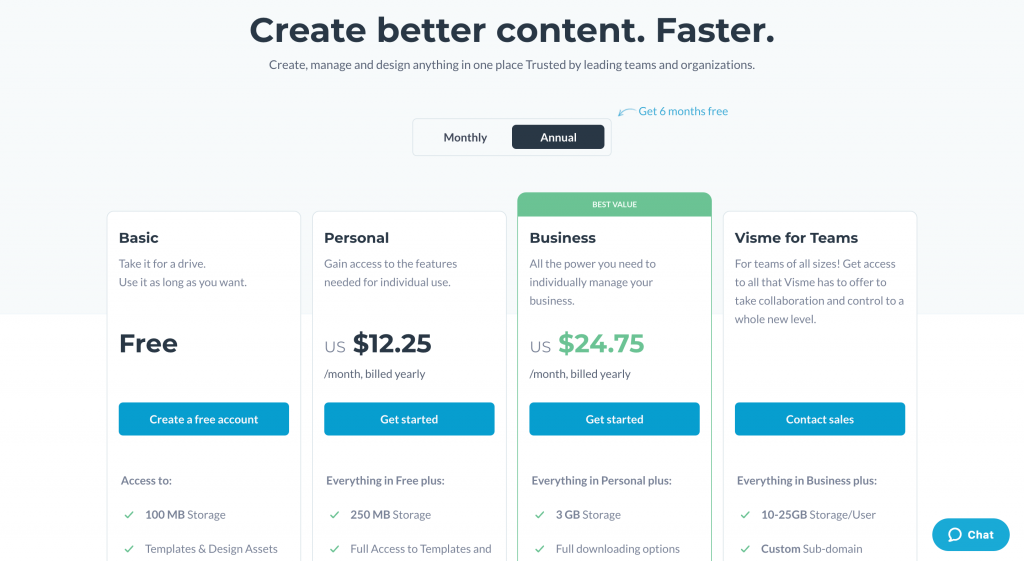
If you want to focus on branding, it’s better to opt for the Business plan as it includes the Brand Kit you’ll need to launch your strategy. The Visme for Teams subscription is customizable and includes all features available in the other two subscriptions + more storage per user.
The last tool on our list is Creatopy – let’s see what it has to offer.
Design & creative tool #3: Creatopy
Creatopy is an online design platform that helps businesses create visual content for advertising campaigns.

You can either use the tool’s wide selection of templates or craft an ad copy from scratch by downloading your branded visual assets and using pre-set formats according to the platforms where your ads will be displayed.
Who is it for?
Go for Creatopy if you need assistance with creating visuals for advertising campaigns, no matter where you choose to run them.
Creatopy features
Creatopy includes the following features in its toolkit:
- Automation
- Animation
- Customization
- Brand alignment
- Ad serving
- Collaboration
These tools can help you both create an ad from scratch or customize an existing template. All-in-all, this platform can assist you with making the following types of ads:
- Display ads (banners, mobile, amp, GIF, HTML5, shoppable, animated, and email ads)
- Social media ads (Facebook, Instagram, YouTube, TikTok, LinkedIn, Twitter, Facebook cover, Instagram Story, Twitter header, LinkedIn banner)
- Industry (real estate, shopping, financial, travel, entertainment)
You can also have the toolkits customized based on the type of business you own – enterprise, brand, or agency.
Creatopy pricing
You can sign up for Creatopy’s free trial or book a demo to see what the tool is like. The cheapest Create plan costs $17 a month.
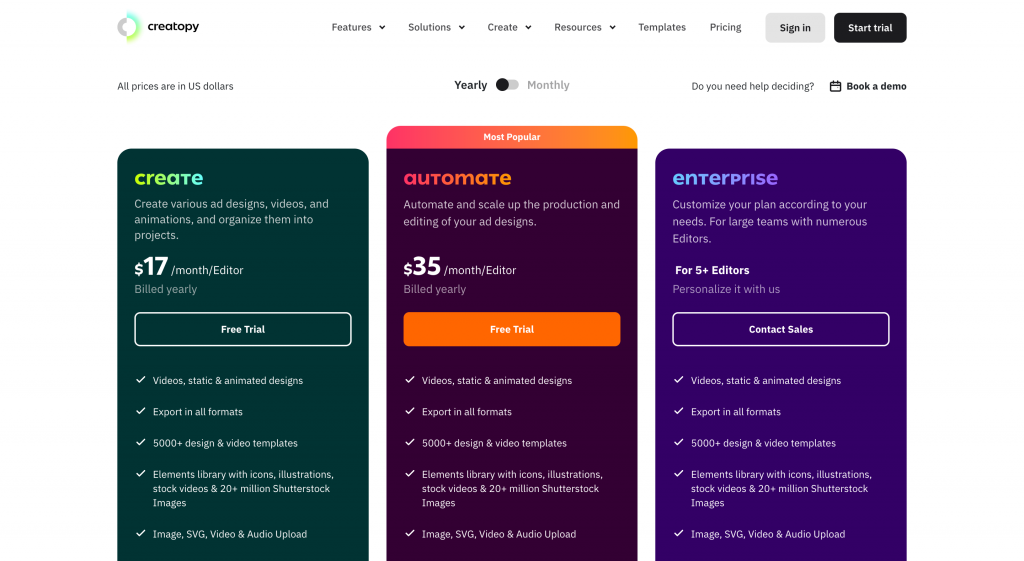
The Create and Automate plans only allow connecting one user, which should be enough for a small or mid-size company. However, digital marketing agencies should consider the Enterprise subscription, which allows 5+ editors. However, you will have to negotiate a price for it with the sales team.
Over to You
Phew, that was quite an extensive list of tools!
We must say that all of them will serve you well, no matter whether you need help with SEO, social media, email marketing, or any other strategy.
There is, of course, the matter of price – some of these solutions can be quite costly and not suitable for teams with small budgets. However, in each category, you can find a cheaper alternative, and some of the tools presented also have freemiums.
So, study your needs, consider your budget, and make your choice.
Found this article helpful? Check out other pieces on our blog – we cover all things digital marketing here.

Mariia is a content strategist and editor at Digital Marketer’s World. She is passionate about educating others on all things marketing and believes in the power of the written word.
